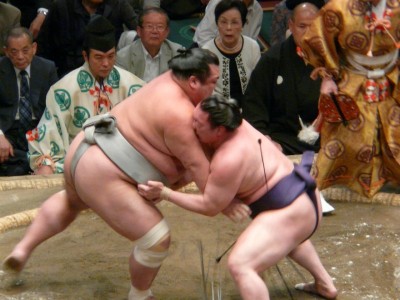Our day today was topped off by an activity straight from my own bucket list: an evening at one of the major sumo wrestling tournaments. One thing is certain: the experience did not disappoint!
While it is not terribly surprising that a night spent as a member of an excited crowd cheering on highly-trained athletes as they engage in battles of wills and brawn would be great fun, it is probably more surprising that the evening also amplified and deepened our understanding of the Shinto ideas and practices our group had studied earlier that day at the Meiji Shrine.
Sumo has been intimately tied to Shinto and Shinto ritual from the very beginning. According to the myths recorded in the ancient Record of Ancient Matters, it was a sumo match between two deities that decided which should rule Japan. Human sumo matches, in turn, began to be held and dedicated to the kami at Shinto shrines as many as 1500 years ago. The sport continued through the Nara, Heian, Kamakura and Tokugawa periods – and came into the modern world with the support of the Meiji Emperor.
The many ways contemporary sumo still preserves – and is constituted by – this rich heritage was on display tonight. The bouts take place under a “Shinto-style” roof. Each match begins with now-familiar rituals: the wrestlers engage in an elaborate series of hand claps and leg stomps to alert the kami – and rinse their mouths and throw salt in the ring to purify themselves and the area. (We also clapped our hands and rinsed our mouths at the Meiji Shrine. It was probably for the best that we did not also attempt to perform the leg stomps or throw salt as they do!) After the match, the winner expresses gratitude for the win and winnings through traditional gestures. Those wrestlers who have attained the highest levels of the sport (the yokuzuna) wear the rope and zigzagged paper that Shinto uses to mark things deserving of great awe, such as trees, rocks, and shrines. Fittingly, grand champions also perform their first ring-entering ceremony at the Meiji Shrine.
Our morning guides at the Meiji Shrine characterized Shinto as “the way of Japanese life,” and highlighted its use of ritual to emphasize and appreciate the sacredness and unexplainable power of nature and life. It seems terrifically fitting that these incredible athletes should both participate in and be objects of such celebration!







I had assumed the salt on the floor was to make it more difficult and painful if you lost your balance. Or is the amount of salt too small to have that effect?
Sounds like quite an experience!
The salt-throwing is – like so many actions in Shinto – a ritual purification. (Margaret’s friend explained that the wrestlers need to be purified so that they can better demonstrate their ‘natural ability.’) This is not to say that the salt couldn’t ALSO work to make things more uncomfortable for them – I understand that up to 80 pounds are thrown in EACH match! Even though special attendants were constantly sweeping the ring, I certainly wouldn’t have wanted to go down out there – for that and plenty of other reasons! No word on whether the salt is recycled though, Susan. 🙂